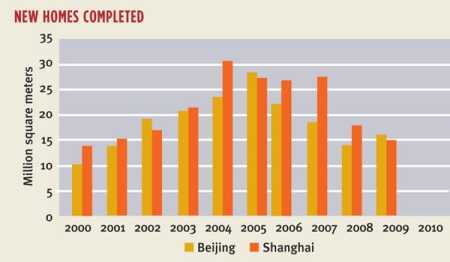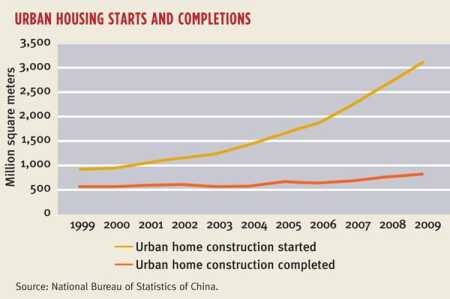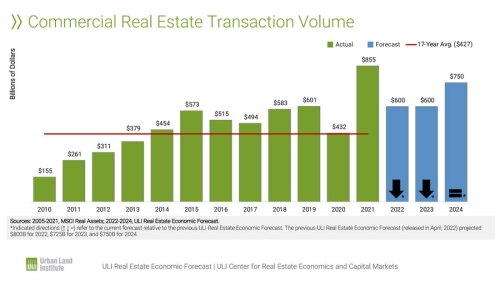Unique conditions in mainland China could moderate the effects of a market correction.
Debate about mainland China’s property bubble recently has seemed to cease being about whether the bubble exists. Instead, popular conjecture has turned to when it will burst and how bad the aftermath will be.
After almost two years of the Chinese central government rolling out increasingly stringent policy measures designed to bring down property prices, a growing number of developers have started cutting new home prices by as much as 20 percent to revive stalled sales. Recent market data show substantially reduced sales volume for both newly built homes purchased from the developer and existing homes, and price declines for sales of existing homes in major cities. This suggests that a price correction may have already started.
However, the impact of this correction likely will be less severe and shorter in duration than feared by many Western observers because of several factors unique to mainland China.
Historical Perspective
| A neighborhood a few blocks away from the |
For mainland China’s urban residents with hukou, or permanent residency permits, the homeownership percentage stands at about 89 percent, mainly thanks to the privatization of housing that took place between 1998 and 2003. Starting in 1998, rental housing stock belonging to public sector institutions and state-owned companies was sold to the occupants at heavily subsidized prices. Moreover, development of new homes, which had long been the responsibility of the state, was largely left to for-profit enterprises that would sell units to individuals at market price.
Between 1998 and 2010, urban housing stock increased by 89 billion square feet (8.3 billion sq m) gross floor area (GFA), substantially alleviating the severe housing shortage. As a result, average urban housing space per capita has doubled to more than 323 square feet (30 sq m) GFA. The achievement is even more remarkable when one considers that during the same period, China’s urban population rose by 200 million, equivalent to nearly two-thirds of the U.S. population. Now, about 51 percent of the mainland Chinese population of 1.3 billion resides in cities, compared with 36 percent a decade ago.
However, success in expanding the urban housing stock has been accompanied by a rapid increase in housing prices, making a home purchase increasingly challenging for low- and middle-class households and, in particular, for migrants and young white-collar workers.
| Demographic Trends With just over 50 percent of the population now residing in cities, China still has more urbanization ahead over the next two decades as the percentage living in cities climbs toward an expected 70 to 80 percent. This represents an additional 300 million to 400 million people moving from the countryside into cities, creating tremendous demand for housing. The approximately 15 million migrants moving to cities each year will be increasingly better educated than their predecessors, with many having four-year college educations. In 2010, new college graduates numbered 6.3 million, an increase of over 300 percent from 1999. |
In 2007, worried about a looming property bubble and high inflation, the Chinese government began imposing policy measures to cool the property market. These so-called austerity measures included increasing mortgage interest rates for buyers of multiple homes, requiring developers to increase equity investment for development projects, and imposing additional conditions for bank borrowing by developers. As a result, home sales volume dropped by more than 10 percent in 2008 from a year earlier. In Shanghai, home sales volume was nearly halved. The dire conditions for the property sector were illustrated by the nearly 70 to 80 percent drop in share price for most of the mainland Chinese developers listed on the Hong Kong Stock Exchange and an over 50 percent discount in price for many of their bonds.
However, less than a year after introducing the austerity measures, the Chinese government reversed itself in reaction to the global financial crisis, releasing 4 trillion renminbi ($635 billion) as part of its stimulus package and adopting a loose monetary policy. Starting in late 2008, buyers of a first home were given a 30 percent discount on mortgage loan interest. As a result, home sales volume in 2009 returned to the 2007 level, and prices, which had stalled in 2008, resumed their climb. Also, 2009 and 2010 saw land sales at record-breaking prices that were often close to the value of nearby homes, spawning a popular saying, “Flour is more expensive than bread.”
Alarmed again by increasing inflation and runaway home prices, the Chinese government stepped on the brakes starting in early 2010, releasing a series of aggressive austerity measures such as canceling the 30 percent discount on the mortgage interest rate for first-time buyers, increasing the downpayment requirement to 30 percent for first-time homebuyers and to 50 percent for buyers of second homes, and prohibiting additional purchases by people who already owned two homes.
At the same time, the central government embarked on an ambitious plan to construct 5.9 million new low-income housing units each year and another 36 million new units during the 12th five-year plan period, 2011 to 2015. The government’s goal is to provide 20 percent of urban households with government-sponsored affordable housing by 2015.
| A stalled residential development project in Changning, Shanghai. |
Whereas some observers in China and elsewhere have sneered at the 36 million–unit program, mocking it as a new Great Leap Forward launched by the Chinese government, many analysts believe the government is launching its public housing program with the aim of killing two birds with one stone—making housing affordable to those at the bottom of society while also stimulating demand and cushioning any slowdown after decades of breakneck growth. The Chinese are seeking to avoid the type of severe economic downturn experienced in the West following the bursting of the subprime mortgage bubble in the United States.
How Bad Is the Real Estate Bubble in China?
According to government data, mainland China’s average commodity housing price rose from less than 2,000 renminbi per square meter ($29 per sq ft) of GFA in 2000 to over 4,700 renminbi ($69 per sq ft) in 2010, an increase of 142 percent, or a compound annual growth rate of 9.2 percent. This nationwide housing price increase is generally in line with the historical annual growth in gross domestic product (GDP) of 8 to 12 percent. These figures are often cited by those who argue that the property bubble does not exist or is limited to certain major cities such as Beijing and Shanghai, where average commodity housing prices rose 300 percent during the same period to 17,000 renminbi per square meter ($251 per sq ft) of GFA in Beijing and 15,000 renminbi per square meter ($221 per sq ft) in Shanghai.
Much like in the United States, the extent of the bubble varies among regions and cities in mainland China. The bubble is seen as more severe in the tier-one and tier-two cities in the more affluent coastal regions and less so in inland cities of the southwest and the northeast. The current housing price level is substantially higher when based on nongovernment data that exclude government-subsidized housing sales. For instance, in Shanghai, the current average commodity housing price for a new home excluding government-subsidized housing units is reported to be around 24,000 renminbi per square meter ($354 per sq ft). For a standard-sized unit of 90 sq m (970 sq ft) of GFA—which typically has a net floor area of around 72 sq m (780 sq ft), typically with two bedrooms and one bathroom—the average new home in Shanghai sells for over 2.1 million renminbi ($310,000), well over 20 times Shanghai’s average household disposable income.
The situation looks less dire when one uses the average price for an existing home of around 15,000 renminbi per square meter ($221 per sq ft), though for a home with 90 sq m (970 sq ft) of GFA, the price still is about 14 times the average annual household disposable income.
Another indicator of excessive home prices is the low gross rental yield of homes, which generally ranges between 2 and 3 percent in many cities. This rental yield is below the one-year bank deposit rate of 3 percent, suggesting that homebuyers are expecting substantial capital gains to make up for the low current yield.
However, for most homeowners who acquired their homes during the privatization period or before the price surge that started in 2007, a price drop of 30 percent or more should have limited impact for three reasons: their substantial capital gains, often exceeding 200 percent; the absence or limited reliance on mortgage loans; and double-digit income growth.
The Chinese often buy homes without any mortgage borrowing or with a large downpayment that is well above the legally required minimum. As a result, mortgage loans represent only 14 percent of China’s GDP—compared with about 40 percent in the United States and other developed countries—and 18 percent of total household savings.
Another unique aspect of mainland China’s bubble is that in the event of a real estate downturn, it likely would be the rich who would be hurt most. Recent surveys show that more than half the buyers of new homes own multiple homes, and the overwhelming majority of buyers belong to the top 10 to 20 percent income brackets. Even if the value of their recently acquired homes declines, many speculative buyers may be sitting on healthy investment gains on other homes acquired during the privatization period and before the price surge in 2007. As a result, it is unlikely that a substantial price correction of, say, 30 percent would force many homeowners into a negative equity situation.
What Caused the Bubble?
The most immediate cause of the price increase seen in the past few years is the government’s loose monetary policy. Outstanding mortgage loan balances increased to over 4.5 trillion renminbi ($715 billion) by the end of 2010, an increase of 80 percent from the 2007 year-end level of 2.5 trillion renminbi ($397 billion).
New housing supply has steadily declined over the past several years, creating a shortage. Especially in 2009, when the government lifted its austerity measures in favor of a looser monetary policy to help spur the economy in the midst of the global financial crisis, demand far exceeded the available housing supply, which had been adversely affected by limited funding available to developers in 2008. The completion rate for homes under construction, which formerly had been in the high 30 percent range, decreased to the low 20 percent range over the past decade, suggesting that it now takes longer for developers to complete construction. It appears that the recent drop in new housing completions may have been too steep, given the continuing urbanization and upgrade demand from the growing middle class.
Rapidly rising relocation costs also are believed to have contributed to rising land prices. Especially in urban cores of tier-one and tier-two cities, the demolition of old homes to allow new development—with the occupants being compensated in the form of cash or a new unit in a different location—has become not only expensive, but also has slowed substantially, often blocked by a small group of remaining residents. Local governments have become much more sensitive to the demands of the affected residents, who in turn have become more demanding regarding compensation.
As for variations in home affordability among cities, one key cause is differing amounts of demand from outsiders. Tier-one cities and regional urban centers have been the primary focus for home purchases for investment. In particular, high-end properties in Shanghai and Beijing have attracted many wealthy people from other cities, as well as Hong Kong residents and overseas Chinese who would like to establish residence in the mainland’s two main gateway cities. Also, many local companies based in regional centers are moving their headquarters to Beijing and Shanghai or expanding operations there to attract top talent and to take advantage of the relative ease of operating in these world-class cities.
Another key cause of pricing variation is differing local regulations that may affect supply and demand, such as the allowable development plot ratio or floor/area ratio (FAR). For example, FAR for residential towers in Guangzhou can be twice that of buildings in Shanghai or Beijing. Top-end newly built homes in downtown Guangzhou sell for about 40,000 renminbi per square meter ($590 per sq ft), whereas similar products in Shanghai are priced at over 100,000 renminbi per square meter ($1,475 per sq ft). The low FAR in some cities renders redevelopment of urban cores with an existing high population density economically difficult, and over time has reduced the land area feasible for development.
Prospects for Residential Real Estate
In the near term, more developers will start discounting prices to revive sales and shore up their cash holdings. Some have started disposing of properties previously held for investment and selling equity stakes in development projects. The next several months should be critical as short-term trust loans obtained by many developers two years ago—at the start of the government austerity measures—begin to mature.
However, it is unlikely that a wave of developers will go bankrupt. For the past year or so, many developers stopped acquiring land from government auctions. In the next couple of years, land sales between developers will increase. Developers who were active in land acquisition in the past few years at record-breaking prices stand to suffer the most; however, even they may not fare too badly if they hold large land banks obtained earlier at low prices. Many of the active buyers of land at record-breaking prices over the past few years are publicly listed entities with substantial state ownership and thus have relatively easy access to bank financing. Moreover, developers likely will be aided by improving supply and demand dynamics. A slower pace of new housing starts, caused by limited availability of construction financing, combined with austerity measures, likely will lead to a near-term reduction in supply, just as it did in 2008 and 2009, thereby providing a floor for prices.
The most persuasive reasons for a positive outlook for the Chinese real estate industry are continuing urbanization, positive long-term growth fueled by significant gains in labor productivity, and growing demand for upgraded homes by middle- and upper-income households. The rapid pace of construction in the past, while critical for expansion of the housing inventory to meet immediate demand, unfortunately often was characterized by poor design and construction. The increasingly affluent and sophisticated middle- and upper-middle-class households will demand new, higher-quality homes.
In the long term, a major real estate market stumble in mainland China that causes a major economic recession cannot be ruled out, given the central role real estate plays in China’s growth. However, such a market collapse is highly unlikely in the near term, while the country is still undergoing rapid urbanization and productivity gains, and while the government remains vigilant and proactive in addressing potential property bubbles.
It is critical that the Chinese government have a housing policy to address the needs of the majority in any potential economic downtimes. In the 1980s, when China experienced massive unemployment, the government adopted a market approach to job creation with debt financing of massive infrastructure projects. Today the government is looking at a long-term land allocation plan oriented toward economic restructuring and seen as a tool to control economic cycles. Who will benefit from these policy shifts? Government intervention may be a short-term solution and support state-owned “national champion” developers who have become much more active over the past few years. However, this shift also poses considerable risk, creating a moral hazard arising from national champions who become too big to fail.
China is confronting its addiction to real estate and has faced up to the reality that it needs to free itself from overdependence on this sector if it is to restructure successfully. The housing sector itself is a strategic tool to provide stability and manage the economy. Getting out of the property track is not easy, but doing so is urgent because an unproductive economy heightens the chances of social unrest.
A perception of fair property prices and controlled inflation is very important to the Chinese government; a loss of confidence could be dangerous. Doomsayers have so far been proven wrong. Let’s hope they are wrong again.
Attend Urban Land Institute’s first
Asia Pacific Summit
May 16 - 18, 2012 in Beijing, China.






